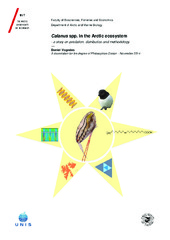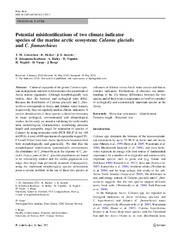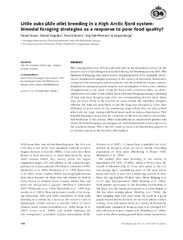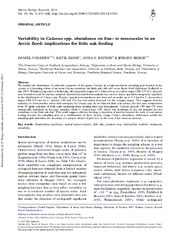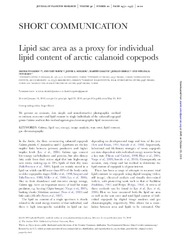| dc.contributor.advisor | Berge, Jørgen | |
| dc.contributor.author | Vogedes, Daniel Ludwig | |
| dc.date.accessioned | 2014-11-10T14:11:45Z | |
| dc.date.available | 2014-11-10T14:11:45Z | |
| dc.date.issued | 2014-11-19 | |
| dc.description.abstract | The calanoid copepods of the genus Calanus (C. finmarchicus, C. glacialis and C. hyperboreus) are key elements in the Arctic ecosystem. They link primary producers (ice algae, phytoplankton) and higher trophic levels through their ability to convert low energy carbohydrates and proteins to high energy wax esters. This energy is stored in a separate and conspicuous lipid sac. This ability to store large amounts of compact energy is considered an essential adaptation towards the strong seasonality in the Arctic environments. Also the calanoid copepods are known to conduct pronounced seasonal vertical migration and diapause at depth.
Due to the large amount of stored energy, Calanus spp. is a preferred prey for a number of planktivorous predators such as herring, polar cod and little auks.
The three Calanus spp. share a very similar morphology but have a very different life history and they are bound to different types of water masses: C. finmarchicus has a one year life cycle, indicator of Atlantic water; C. glacialis 1-3 year cycle, indicator of Arctic shelf water; C. hyperboreus 1-5 years, indicator of Arctic water. For this reason the Calanus spp. have long been considered a reliable climate indicator species. Also, they vary in size and thus in total amount of stored lipids, an important factor for those species foraging on Calanus spp.
The aim of this thesis was to evaluate the ecological role of the important climate indicator Calanus spp. Two technical papers provide tools for Calanus spp. research. In paper 1 the potential misidentification of C. glacialis as C. finmarchicus is discussed. Genetic analysis revealed that at several localities a variable percentage of C. finmarchicus is wrongly identified as C. finmarchicus when traditional morphological identification methods are applied. Paper 4 provides an equation to convert copepod lipid sac area obtained by optical measurements to energy content and thus allows comparison of individual state of copepods within and across all three species.
Prey selection of chick-rearing little auks depending on zooplankton availability in the adjacent waters was the focus of paper 2 and 3. Little auks displayed a bimodal foraging strategy, presumably as a response to poor feeding conditions close to the colony. Prey count and travel time recordings indicate long travels to the shelf edge for self-maintenance feeding on high energetic C. hyperboreus and C. glacialis and short trips for collection of food for the chicks. An unexplained mismatch of prey ratio in returning birds versus samples at sea remains. Close to the bird colony a high-resolution zooplankton sampling grid was applied which revealed the occurrence of a zooplankton patch of 0.2 to 2 km. Total energy content of little auk prey m-3 was 16 times higher in the patch than in the place of lowest abundance. The presence of zooplankton patches is highly relevant not only for little auks searching for their food (concentration of food – less feeding effort), but in fact also for zooplankton research itself (hitting or missing a patch during a sampling campaign will give largely different results).
In paper 5 the focus is on variations in vertical distribution of Calanus spp. and Metridia longa in autumn. Older and larger copepodite stages were located deeper in the water column and the distribution reflected the variation in seasonality on a south-north gradient. Diel vertical migration (DVM) was only observed for M. longa.
It was a paradigm that biological activity in the polar night more or less comes to a halt, but in paper 6 a pattern of synchronized DVM could for the first time be demonstrated for two Arctic fjords, Kongsfjorden and Rijpfjorden, during the darkest time of the year. In this paper calanoid copepods were suggested as actively migrating during winter. | en |
| dc.description.doctoraltype | ph.d. | en |
| dc.description.popularabstract | Som en liten feit lykkepille svømmer den rundt i de arktiske hav. Alle vil ha den, og mange er avhengig av den.
I denne avhandlingen har jeg studert raudåta, ishavsåta og feitåta, tre nært beslektede arter hoppekreps som står sentralt i de marine økosystemene i nord. Felles for alle tre er at de hovedsakelig lever av intense våroppblomstringer som kjennetegner nordlige marine økosystemer og ikke minst at de har evnen til å lagre store mengder energi i form av flytende fett i kroppen. Dette gjør at hvert enkelt individ har usedvanlig mye næring i forhold til kroppsstørrelse. Men de tre artene har også viktige forskjeller. De er forskjellige mhp størrelse, livslengde og hvilke havområder de trives best i. Jeg har i denne doktorgraden sett nærmere på utbredelsesmønster, metodikk for både estimering av næringsinnhold og genetisk artsindentifisering, potensielle aggregeringer i et naturlig habitat og betydningen av disse artene som føde for alkekongen. Resultatene av dette arbeidet er fordelt på 6 vitenskapelige arbeider, og representerer et viktig steg i retningen av å forstå effekter av klimaendringer. | en |
| dc.description.sponsorship | University Centre in Svalbard (UNIS)
University of Tromsø (UiT) | en |
| dc.description | Papers number 5 and 6 of the thesis are not available in Munin due to publishers' restrictions: <br>5. Daase, M., Eiane, K., Aksnes, D. L. and Vogedes, D.: 'Vertical distribution of Calanus spp. and Metridia longa at four Arctic locations', Marine Biology Research, 4(2008), 193-207, available at <a href=http://dx.doi.org/10.1080/17451000801907948>http://dx.doi.org/10.1080/17451000801907948</a> <br>6. Berge, J., Cottier, F., Last, K. S., Varpe, Ø., Leu, E., Søreide, J., Eiane, K., Falk-Petersen, S., Willis, K., Nygard, H., Vogedes, D., Griffiths, C., Johnsen, G., Lorentzen, D. and Brierley, A. S.: 'Diel vertical migration of Arctic zooplankton during the polar night', Biology Letters, 5(2009), 69-72, available at <a href=http://dx.doi.org/10.1098/rsbl.2008.0484>http://dx.doi.org/10.1098/rsbl.2008.0484</a> | en |
| dc.identifier.isbn | 978-82-8266-088-4 | |
| dc.identifier.uri | https://hdl.handle.net/10037/6807 | |
| dc.identifier.urn | URN:NBN:no-uit_munin_6407 | |
| dc.language.iso | eng | en |
| dc.publisher | UiT The Arctic University of Norway | en |
| dc.publisher | UiT Norges arktiske universitet | en |
| dc.rights.accessRights | openAccess | |
| dc.rights.holder | Copyright 2014 The Author(s) | |
| dc.rights.uri | https://creativecommons.org/licenses/by-nc-sa/3.0 | en_US |
| dc.rights | Attribution-NonCommercial-ShareAlike 3.0 Unported (CC BY-NC-SA 3.0) | en_US |
| dc.subject | VDP::Mathematics and natural science: 400::Zoology and botany: 480::Marine biology: 497 | en |
| dc.subject | VDP::Matematikk og Naturvitenskap: 400::Zoologiske og botaniske fag: 480::Marinbiologi: 497 | en |
| dc.title | Calanus spp. in the Arctic ecosystem
- a story on predation, distribution and methodology | en |
| dc.type | Doctoral thesis | en |
| dc.type | Doktorgradsavhandling | en |


 English
English norsk
norsk